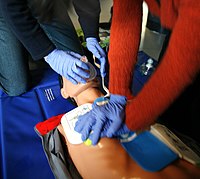
Photo from wikipedia
BACKGROUND Prehospital cardiopulmonary resuscitation has commonly been considered ineffective in traumatic cardiopulmonary arrest because traditional chest compressions do not produce substantial cardiac output. However, recent evidence suggests that chest compressions… Click to show full abstract
BACKGROUND Prehospital cardiopulmonary resuscitation has commonly been considered ineffective in traumatic cardiopulmonary arrest because traditional chest compressions do not produce substantial cardiac output. However, recent evidence suggests that chest compressions located over the left ventricle (LV) produce greater hemodynamics when compared to traditional compressions. We hypothesized that chest compressions located directly over the LV would result in an increase in return of spontaneous circulation (ROSC) and hemodynamic variables, when compared to traditional chest compressions, in a swine model of traumatic pulseless electrical activity (PEA). METHODS Transthoracic echocardiography was used to mark the location of the aortic root (traditional compressions) and the center of the LV on animals (n = 34) that were randomized to receive chest compressions in one of the two locations. Animals were hemorrhaged to mean arterial pressure <20 to simulate traumatic PEA. After 5 minutes of PEA, basic life support (BLS) with mechanical cardiopulmonary resuscitation was initiated and performed for 10 minutes followed by advanced life support for an additional 10 minutes. Hemodynamic variables were averaged over the final 2 minutes of BLS and advanced life support periods. RESULTS Six of the LV group (35%) achieved ROSC compared to eight of the traditional group (47%) (P = .73). There was an increase in aortic systolic blood pressure (P < .01), right atrial systolic blood pressure (P < .01), and right atrial diastolic blood pressure (P = .02) at the end of BLS in the LV group compared to the traditional group. CONCLUSIONS In our swine model of traumatic PEA, chest compressions performed directly over the LV improved blood pressures during BLS but not ROSC.
Journal Title: Military medicine
Year Published: 2021
Link to full text (if available)
Share on Social Media: Sign Up to like & get
recommendations!